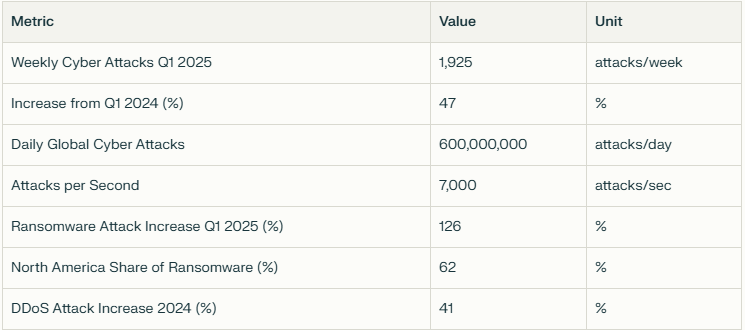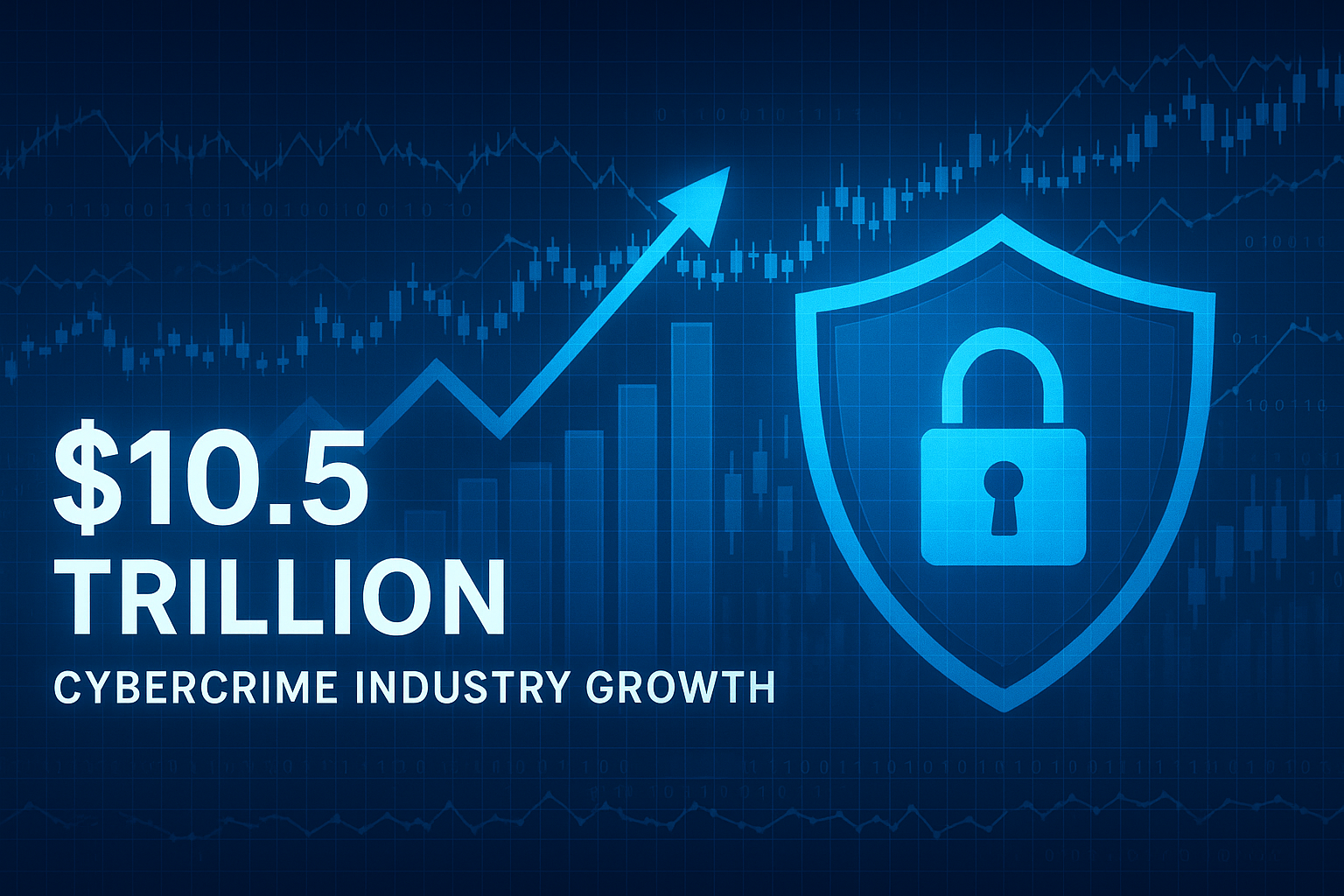Here’s a number that should make every business owner pause. Cybercrime is expected to cost the world $10.5 trillion in 2025, representing a 15% year-over-year growth. To put that in perspective, if cybercrime were a country, it would have the third-largest economy in the world, right behind the United States and China. And here’s what really gets me, while cybercrime damages are growing at 15% annually, global cybersecurity spending is only projected to reach $212 billion in 2025. That means cybersecurity spending is approximately 50 times less than the annual cybercrime cost.
You know what this tells me? We’re losing the war, and small businesses are paying the biggest price.
The Cybercrime Growth Explosion: By the Numbers
The statistics from 2025 are absolutely staggering. Organizations are now facing an average of 1,925 cyber attacks per week in Q1 2025, marking a 47% rise compared to the same period in 2024. Microsoft estimates there are approximately 600 million cyberattacks per day globally. That’s nearly 7,000 attacks every second.
But here’s what really concerns me about these numbers, ransomware attacks specifically increased by 126% in Q1 2025, with North America accounting for 62% of global incidents. DDoS attacks surged by 41% in 2024, and this trend is continuing into 2025.

5 Ways the Cybercrime Industry Is Outpacing Legitimate Business
1. Ransomware as a Service. The Criminal Franchise Model
Ransomware gangs are forming strategic alliances and offering ransomware as a service, making sophisticated attacks available to low-skill criminals. This franchise model means that anyone with basic computer skills can now launch devastating attacks against small businesses. It’s like McDonald’s, but for cybercrime, and it’s incredibly effective.
2. AI Enhanced Attack Automation
While your business might be struggling to adopt AI tools, criminals are using AI to automate vulnerability scanning, create personalized phishing campaigns, and develop adaptive malware. They’re moving faster than most businesses can keep up with their own digital transformation.
3. Supply Chain Attack Multiplication
54% of large organizations cite supply chain challenges as the biggest barrier to cyber resilience. Criminals have figured out that attacking one supplier can give them access to hundreds of downstream businesses. It’s criminal efficiency at its worst.
4. Global Criminal Coordination
The geographic distribution of attacks shows concerning patterns. Africa sees the highest average with 3,286 weekly attacks per organization, while Latin America experienced a 108% year over year increase in attacks. Criminals are coordinating globally while businesses are still thinking locally.
5. Industry Specific Targeting That’s Getting Smarter
Certain sectors are bearing the brunt of increased attacks. Education averages 4,484 attacks per organization each week, a 73% increase from the previous year. Government experiences 2,678 attacks per organization per week, representing a 51% increase. Telecommunications saw a 94% increase, reaching 2,664 attacks per organization weekly.

The Real Cost: What Small Businesses Are Actually Paying
Let me break down what these attacks are really costing small businesses, because the numbers are more devastating than most owners realize:
Direct Financial Impact:
- Small and medium-sized businesses lose around $25,000 on average from cyberattacks
- The average cost for a data breach for a small business is $2.98 million
- 92% of companies with 50 or fewer employees don’t have a dedicated cybersecurity budget
Business Continuity Impact:
- 60% of small enterprises go out of business within six months after a cyberattack
- Downtime costs for small businesses average $427 per minute, or $25,620 per hour
- Nearly 1 in 5 SMBs would be forced to close if a cyberattack cost them as little as $10,000 in damages
Case Study of a Real Pennsylvania Businesses Under Attack
Looking at recent attacks in Pennsylvania and surrounding areas, the patterns are clear. Union County, Pennsylvania faced a ransomware attack that compromised law enforcement and court data. The Pennsylvania State Education Association suffered a breach affecting approximately 500,000 people, including full names, Social Security numbers, and financial account details. A Pennsylvania law firm, Carpenter, McCadden & Lane, discovered their LockBit 3.0 ransomware attack nearly 11 months after it occurred, affecting 7,900 individuals.
These weren’t sophisticated operations with massive IT budgets. These were everyday organizations that got caught in the crossfire of a $10.5 trillion criminal industry.
The Cybersecurity Investment Gap
Here’s the math that keeps me up at night. The global cybersecurity market is projected to reach $301.91 billion in 2025. That sounds like a lot until you realize it’s less than 3% of the expected cybercrime damage costs. It’s like trying to fight a forest fire with a garden hose.
For small businesses, the situation is even more dire:
- 74% of SMBs manage cybersecurity on their own, often without sufficient training
- Only 15% have hired an internal IT professional or outsourced to a managed provider
- 33% of SMBs are working with outdated cybersecurity technology
- 20% report having no cybersecurity technology at all
What This Means for Your Business Strategy
The cybercrime industry is growing faster than most legitimate businesses because it’s operating with fewer regulations, unlimited global reach, and increasingly sophisticated tools. While you’re worrying about quarterly profits, criminals are making annual profits in the trillions.
But here’s the thing, this isn’t a reason to panic. It’s a reason to get strategic. Understanding the scope of the threat is the first step in building an effective defense.
Your Competitive Advantage
While the numbers are scary, there’s an opportunity here. Most of your competitors are just as vulnerable as you are. The businesses that take cybersecurity seriously now will have a significant competitive advantage as the threat landscape continues to evolve.
In my next article, I’ll show you exactly how small businesses in Pennsylvania and surrounding areas are getting attacked, and what you can learn from their mistakes to protect your own business.
Book a 15-minute AI & Cyber Strategy Call to discuss how these industry trends specifically impact your business and what proactive steps you can take.
FAQ
Q: How is the cybercrime industry able to grow so fast?
Cybercrime operates without traditional business constraints like regulations, geographic boundaries, or legal oversight. They can scale globally, automate attacks with AI, and operate 24/7 across multiple time zones.
Q: Why aren’t cybersecurity investments keeping pace with the threat?
Many businesses, especially small ones, still view cybersecurity as an IT expense rather than a business investment. They don’t allocate sufficient budget until after they’ve been attacked.
Q: What makes small businesses such attractive targets?
Small businesses often have valuable data but limited security resources. They’re seen as easy targets with high payoff potential. Plus, they’re less likely to have sophisticated monitoring systems that would detect attacks early.
Sources
- https://www.getastra.com/blog/security-audit/small-business-cyber-attack-statistics/
- https://techaisle.com/blog/600-techaisle-2025-security-survey-reveals-smb-realities
- https://www.vikingcloud.com/resources/vikingclouds-2025-smb-threat-landscape-report-small–and-medium-sized-businesses-big-cybersecurity-risks



